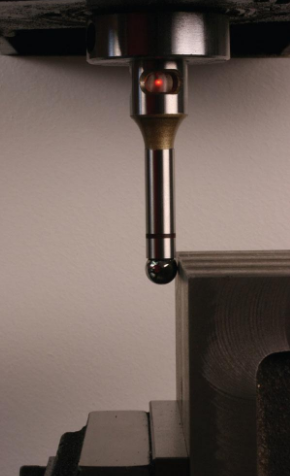Using an Electronic Edge Finder CNC milling work origin
Electronic edge finders are probes that light up when they touch a metal surface. The probe is mounted in the spindle, like a wiggler, but does not turn. The arm of the probe is rigid, except for a spring-loaded ball at the end. The probe body con- tains a battery and a light. The probe body, the battery, the light and the ball form a circuit, but the ball is insulated from the probe body and the circuit is not com- pleted until the probe touches the face of a conductive (usually metal) workpiece. At that point, the circuit is completed through the workpiece and the metal parts of the milling machine, so advancing the probe towards a metal face makes the probe light up when it touches the face (Fig. 2-14). The probe is now half the diameter of the tip away from the face, just like a wiggler. Because the probe is on the left of where we want the work origin to be, enter the X coordinate of where the Con- trolled Point is in relation to the work origin, that is, half the diameter of the tip away, to the left. If the tip is 5mm (0.2in) diameter, enter −2.5mm (−0.1in). The value is negative because the Controlled Point is sitting to the left of the intended
position of the work origin.

The purpose of the spring loading is to protect the probe by allowing the end to move slightly rather than bend the arm of the probe. When using the probe, the aim should be to touch the face without moving the ball, so small movements should be used as the probe gets closer to the face. As with a wiggler, good elec- tronic edge finders should be accurate and repeatable.